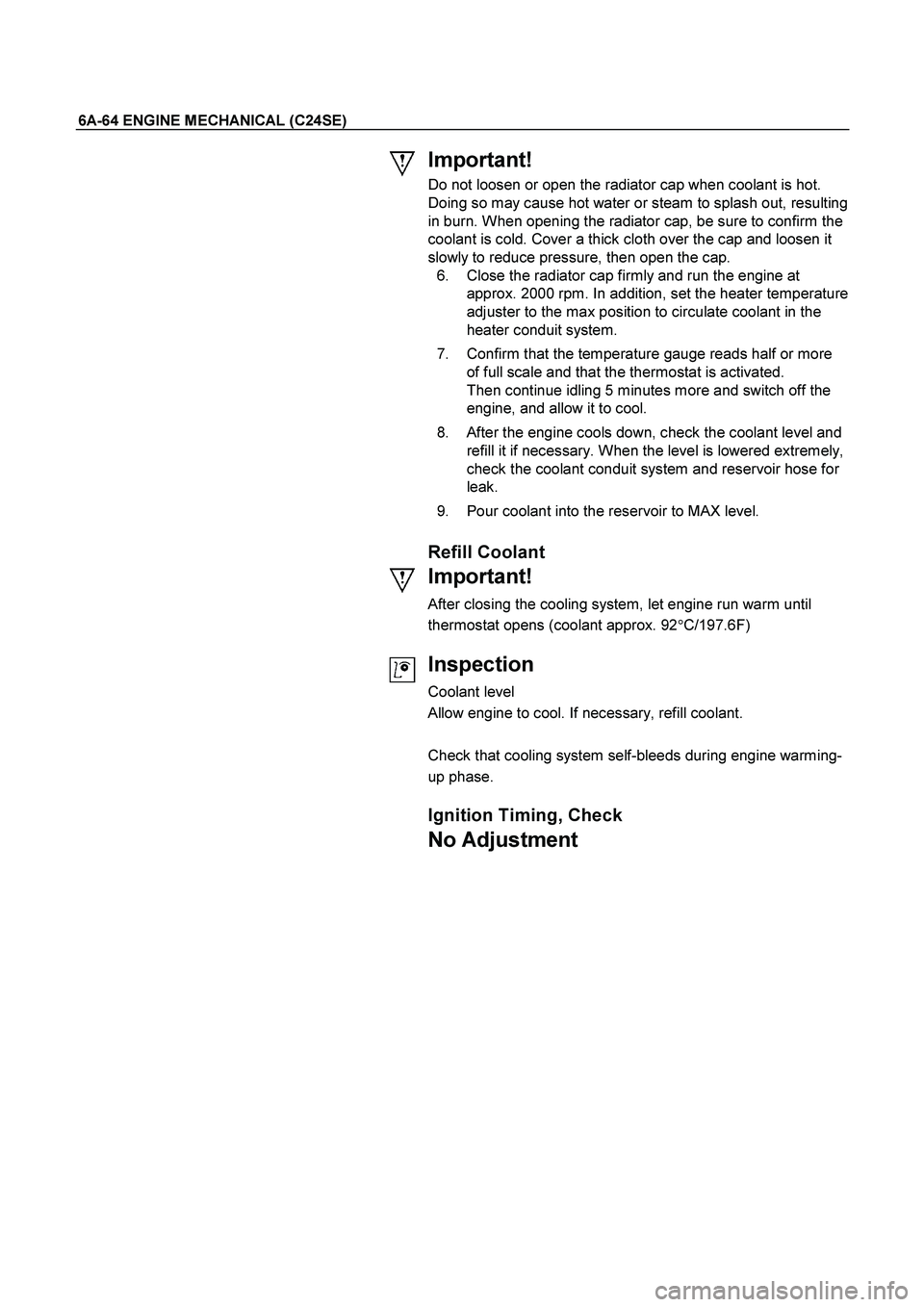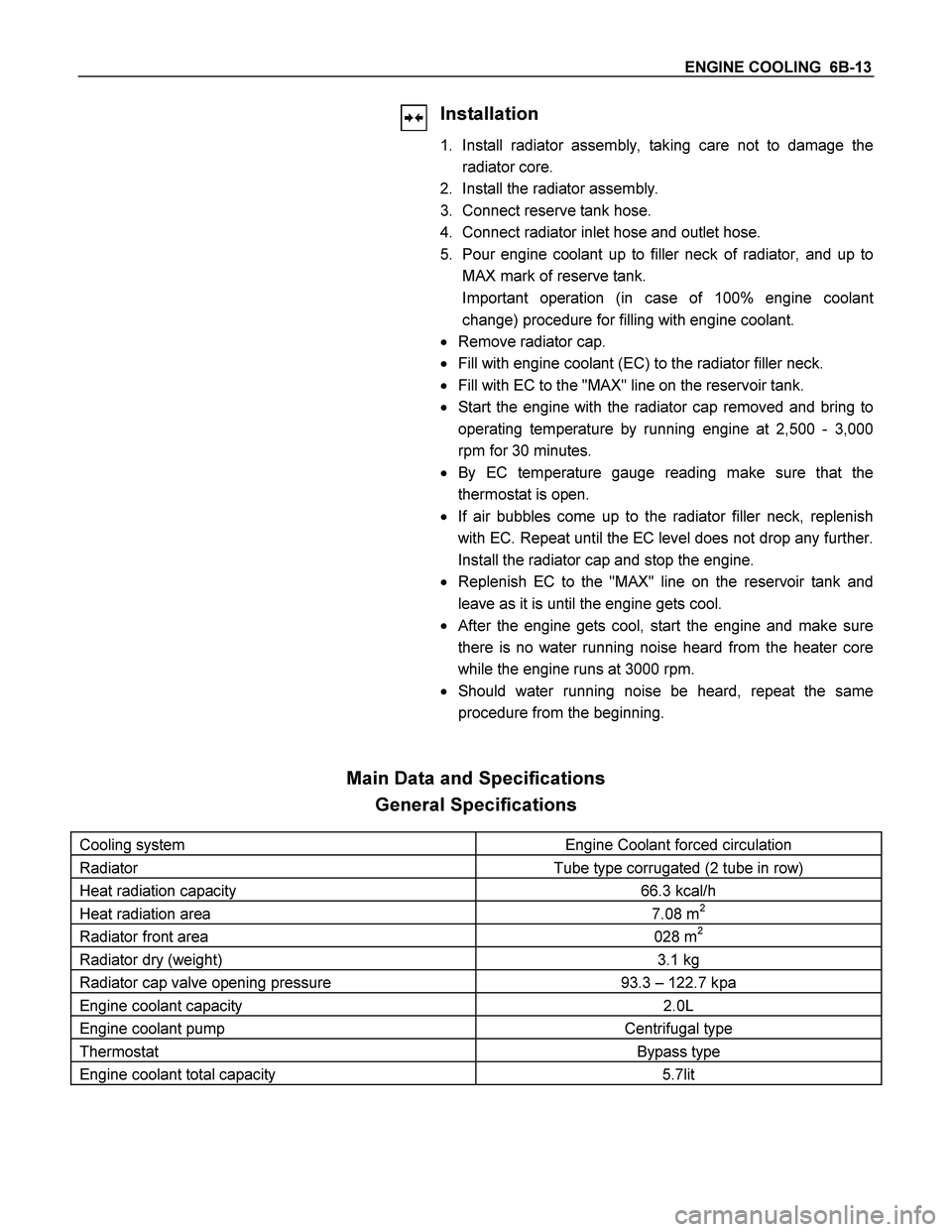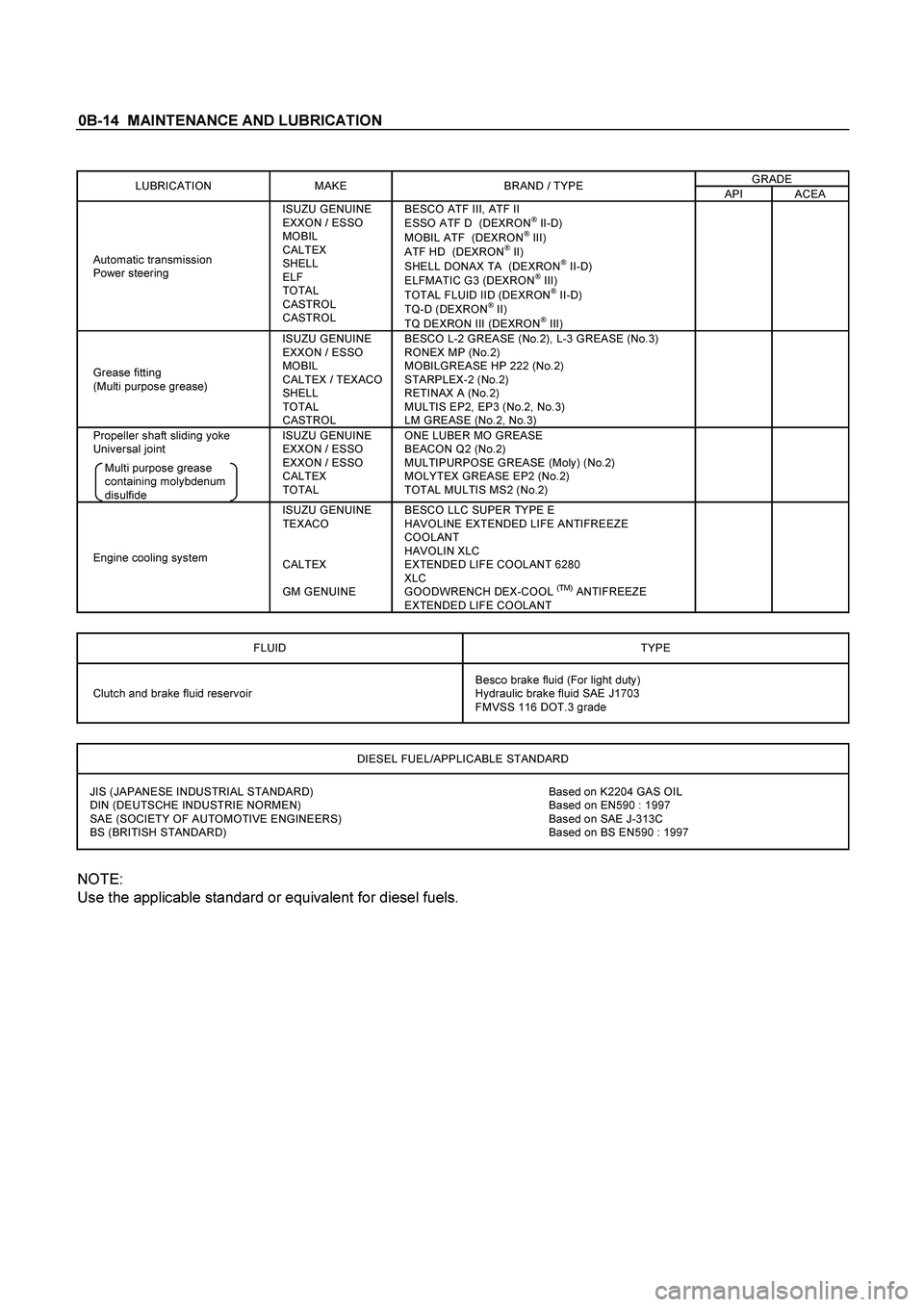Page 2483 of 4264
ENGINE MECHANICAL (C24SE) 6A-63
OPERATIONS ON COOLING SYSTEM
Caution!
Before working with the cooling system, be sure to confirm that
the temperature of the engine is cooled down.
Failure to observe this may cause burn.
Cooling System, Check for Leaks
Installation
1. Install commercially available coolant checking
instrument onto compensation tank (Refer to section 6B;
Engine cooling).
2. Check coolant level.
Inspection
Use 5-8840-0277-0 tester & 5-8840-2603-0 adaptor.
Cooling System, Fill Up and Bleed
Important!
Radiator and heater core are made from alminium.
To avoid corrosion, use only anti-freeze with corrosion
protection.
Replace Coolant
1. Confirm the engine is cold enough.
2. Open the radiator cap, pour coolant to the filler neck level
and close the cap.
3. Pour coolant into the reservoir until MAX line is reached.
4. Start the engine, run 2 �
3 minutes at idling speed and
switch off the engine.
5. Refill coolant if the coolant level is lowered.
Page 2484 of 4264

6A-64 ENGINE MECHANICAL (C24SE)
Important!
Do not loosen or open the radiator cap when coolant is hot.
Doing so may cause hot water or steam to splash out, resulting
in burn. When opening the radiator cap, be sure to confirm the
coolant is cold. Cover a thick cloth over the cap and loosen it
slowly to reduce pressure, then open the cap.
6. Close the radiator cap firmly and run the engine at
approx. 2000 rpm. In addition, set the heater temperature
adjuster to the max position to circulate coolant in the
heater conduit system.
7. Confirm that the temperature gauge reads half or more
of full scale and that the thermostat is activated.
Then continue idling 5 minutes more and switch off the
engine, and allow it to cool.
8. After the engine cools down, check the coolant level and
refill it if necessary. When the level is lowered extremely,
check the coolant conduit system and reservoir hose for
leak.
9. Pour coolant into the reservoir to MAX level.
Refill Coolant
Important!
After closing the cooling system, let engine run warm until
thermostat opens (coolant approx. 92�C/197.6F)
Inspection
Coolant level
Allow engine to cool. If necessary, refill coolant.
Check that cooling system self-bleeds during engine warming-
up phase.
Ignition Timing, Check
No Adjustment
Page 2523 of 4264

ENGINE COOLING 6B-13
Installation
1. Install radiator assembly, taking care not to damage the
radiator core.
2. Install the radiator assembly.
3. Connect reserve tank hose.
4. Connect radiator inlet hose and outlet hose.
5. Pour engine coolant up to filler neck of radiator, and up to
MAX mark of reserve tank.
Important operation (in case of 100% engine coolan
t
change) procedure for filling with engine coolant.
� Remove radiator cap.
� Fill with engine coolant (EC) to the radiator filler neck.
� Fill with EC to the "MAX" line on the reservoir tank.
� Start the engine with the radiator cap removed and bring to
operating temperature by running engine at 2,500 - 3,000
rpm for 30 minutes.
� By EC temperature gauge reading make sure that the
thermostat is open.
� If air bubbles come up to the radiator filler neck, replenish
with EC. Repeat until the EC level does not drop any further.
Install the radiator cap and stop the engine.
� Replenish EC to the "MAX" line on the reservoir tank and
leave as it is until the engine gets cool.
�
After the engine gets cool, start the engine and make sure
there is no water running noise heard from the heater core
while the engine runs at 3000 rpm.
� Should water running noise be heard, repeat the same
procedure from the beginning.
Main Data and Specifications
General Specifications
Cooling system Engine Coolant forced circulation
Radiator Tube type corrugated (2 tube in row)
Heat radiation capacity 66.3 kcal/h
Heat radiation area 7.08 m2
Radiator front area 028 m2
Radiator dry (weight) 3.1 kg
Radiator cap valve opening pressure 93.3 – 122.7 kpa
Engine coolant capacity 2.0L
Engine coolant pump Centrifugal type
Thermostat Bypass type
Engine coolant total capacity 5.7lit
Page 3002 of 4264

0B-14 MAINTENANCE AND LUBRICATION
�
GRADE LUBRICATION MAKE BRAND / TYPE
API ACEA
Automatic transmission
Power steering ISUZU GENUINE
EXXON / ESSO
MOBIL
CALTEX
SHELL
ELF
TOTAL
CASTROL
CASTROL BESCO ATF III, ATF II
ESSO ATF D (DEXRON
� II-D)
MOBIL ATF (DEXRON� III)
ATF HD (DEXRON� II)
SHELL DONAX TA (DEXRON� II-D)
ELFMATIC G3 (DEXRON� III)
TOTAL FLUID IID (DEXRON� II-D)
TQ-D (DEXRON� II)
TQ DEXRON III (DEXRON� III)
Grease fitting
(Multi purpose grease) ISUZU GENUINE
EXXON / ESSO
MOBIL
CALTEX / TEXACO
SHELL
TOTAL
CASTROL BESCO L-2 GREASE (No.2), L-3 GREASE (No.3)
RONEX MP (No.2)
MOBILGREASE HP 222 (No.2)
STARPLEX-2 (No.2)
RETINAX A (No.2)
MULTIS EP2, EP3 (No.2, No.3)
LM GREASE (No.2, No.3)
Propeller shaft sliding yoke
Universal joint
Multi purpose grease
containing molybdenum
disulfide ISUZU GENUINE
EXXON / ESSO
EXXON / ESSO
CALTEX
TOTAL ONE LUBER MO GREASE
BEACON Q2 (No.2)
MULTIPURPOSE GREASE (Moly) (No.2)
MOLYTEX GREASE EP2 (No.2)
TOTAL MULTIS MS2 (No.2)
Engine cooling system ISUZU GENUINE
TEXACO
CALTEX
GM GENUINE BESCO LLC SUPER TYPE E
HAVOLINE EXTENDED LIFE ANTIFREEZE
COOLANT
HAVOLIN XLC
EXTENDED LIFE COOLANT 6280
XLC
GOODWRENCH DEX-COOL
(TM) ANTIFREEZE
EXTENDED LIFE COOLANT
�
FLUID TYPE
Clutch and brake fluid reservoir Besco brake fluid (For light duty)
Hydraulic brake fluid SAE J1703
FMVSS 116 DOT.3 grade
�
DIESEL FUEL/APPLICABLE STANDARD
JIS (JAPANESE INDUSTRIAL STANDARD) Based on K2204 GAS OIL
DIN (DEUTSCHE INDUSTRIE NORMEN) Based on EN590 : 1997
SAE (SOCIETY OF AUTOMOTIVE ENGINEERS) Based on SAE J-313C
BS (BRITISH STANDARD) Based on BS EN590 : 1997
�
NOTE:
Use the applicable standard or equivalent for diesel fuels.